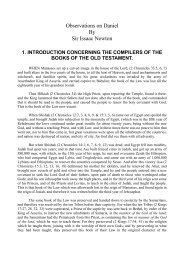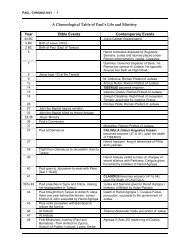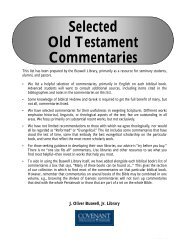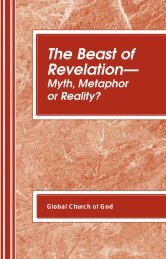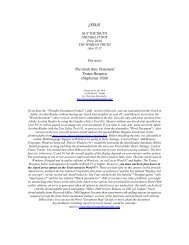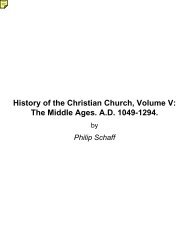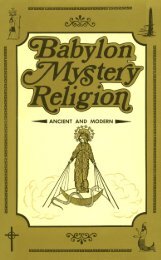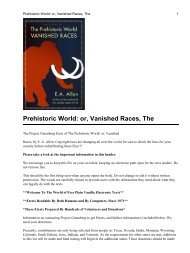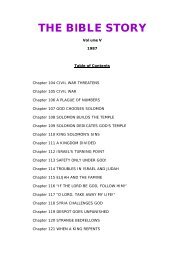Nazarenes_and Ebionites_Rogers.pdf - Friends of the Sabbath ...
Nazarenes_and Ebionites_Rogers.pdf - Friends of the Sabbath ...
Nazarenes_and Ebionites_Rogers.pdf - Friends of the Sabbath ...
You also want an ePaper? Increase the reach of your titles
YUMPU automatically turns print PDFs into web optimized ePapers that Google loves.
The Historic Phenomena <strong>and</strong> Theology<br />
<strong>of</strong> <strong>the</strong> <strong>Nazarenes</strong> <strong>and</strong> <strong>Ebionites</strong><br />
by Dan <strong>Rogers</strong><br />
Notice<br />
This file contains <strong>the</strong> content <strong>of</strong> an undated, uncopyrighted study article prepared<br />
in <strong>the</strong> 1970s by a Pastor <strong>of</strong> <strong>the</strong> Worldwide Church <strong>of</strong> God. The volunteers<br />
preparing <strong>and</strong> circulating this re-release are happy to freely <strong>of</strong>fer it to all who want<br />
it. Excepting this paragraph <strong>and</strong> <strong>the</strong> following exceptions, this file does not differ<br />
from <strong>the</strong> original. Exceptions:<br />
(1) Digital typesetting <strong>and</strong> layout with new pagination. Endnote numbers are<br />
shown in brackets ra<strong>the</strong>r than as superscripts. A few minor changes to<br />
punctuation aid in layout, without changing <strong>the</strong> meaning.<br />
(2) Correcting some spelling.<br />
(3) Attempt to supply words missing or obscured in <strong>the</strong> copy from which this<br />
file was derived, without changing <strong>the</strong> meaning.
The <strong>Nazarenes</strong> <strong>and</strong> <strong>the</strong> <strong>Ebionites</strong><br />
as a Historical Phenomenon<br />
The <strong>Nazarenes</strong> <strong>and</strong> <strong>the</strong> <strong>Ebionites</strong> are two groups which appeared as clearly<br />
defined entities in <strong>the</strong> second century within <strong>the</strong> phenomenon commonly<br />
called “ Jewish Christianity.” The use <strong>of</strong> a term such as Jewish Christianity is<br />
problematic due to <strong>the</strong> multitude <strong>of</strong> meanings associated with it. For <strong>the</strong><br />
purpose <strong>of</strong> this paper, “Jewish Christianity” is used not as a designation <strong>of</strong><br />
origin, hut as <strong>the</strong> designation <strong>of</strong> <strong>the</strong> point <strong>of</strong> view <strong>of</strong> a party. Consequently,<br />
not every Christian <strong>of</strong> Jewish descent can here be regarded as Jewish<br />
Christian. [1]<br />
The Jewish Christians very early came into opposition <strong>and</strong> conflict with <strong>the</strong><br />
European-centered, Gentile-dominated “ Great Church.” There were, <strong>of</strong><br />
course, those <strong>of</strong> Jewish origin who were loyal members <strong>of</strong> <strong>the</strong> “Great<br />
Church.” Justin, writing about <strong>the</strong> middle <strong>of</strong> <strong>the</strong> second century, distinguishes<br />
two groups <strong>of</strong> Christians <strong>of</strong> Jewish origin — moderates who were a part <strong>of</strong><br />
<strong>the</strong> Great Church <strong>and</strong> who, especially in <strong>the</strong> Diaspora congregations,<br />
exercised a Judaizing influence on <strong>the</strong> formation <strong>of</strong> <strong>the</strong>ir doctrine <strong>and</strong><br />
morality; <strong>and</strong> extremists who refused to live with Gentiles who would not<br />
incorporate <strong>the</strong> Jewish law into <strong>the</strong>ir faith in Christ. [2] There were probably<br />
such Jewish Christians who had separated <strong>the</strong>mselves from <strong>the</strong> rest <strong>of</strong> what<br />
was being called Christianity because <strong>the</strong>y combined faith in Christ with<br />
Jewish legal observance. They were to be found in many places such as<br />
Egypt, Mesopotamia, <strong>and</strong> Rome <strong>and</strong> for a long time. [3]<br />
There is a clear pr<strong>of</strong>ile only <strong>of</strong> <strong>the</strong> Jewish Christians <strong>of</strong> Palestine-Syria, who<br />
insistently emphasized <strong>the</strong>ir connection with <strong>the</strong> original cell <strong>of</strong> Christianity in<br />
Jerusalem <strong>and</strong> Galilee. This, <strong>and</strong> most <strong>of</strong> <strong>the</strong> information we have about <strong>the</strong>m,<br />
comes from literary remains attributed to <strong>the</strong>ir circles. The polemic writings<br />
<strong>of</strong> <strong>the</strong> “Church Fa<strong>the</strong>rs” about <strong>the</strong> various Jewish Christian groups are<br />
unreliable due to obvious prejudice against those who would oppose <strong>the</strong>ir<br />
teachings. The Jewish Christians had independent <strong>the</strong>ological <strong>and</strong> literary<br />
traditions, <strong>and</strong> represented, from <strong>the</strong> turn <strong>of</strong> <strong>the</strong> century to <strong>the</strong> third century, a<br />
group which was independent <strong>of</strong> <strong>the</strong> “Great Church” <strong>and</strong> whose outward<br />
form does not conform with <strong>the</strong>ir hesiological characterization. [4]<br />
Ebionite<br />
The names under which <strong>the</strong>se Jewish Christians appear in <strong>the</strong> lists <strong>of</strong> sects<br />
provided by <strong>the</strong> Church Fa<strong>the</strong>rs were originally honorable names in <strong>the</strong> NT
ut <strong>the</strong>ir meanings had since deteriorated. Ebionim or “ <strong>Ebionites</strong>,” is a<br />
rehebraized ancient title <strong>of</strong> honor which <strong>the</strong> primitive church adopted,<br />
probably after <strong>the</strong>ir flight from Jerusalem, on <strong>the</strong> basis <strong>of</strong> Jesus’ beatitudes<br />
concerning <strong>the</strong> “poor.” There was no one named Ebion, who served as fa<strong>the</strong>r<br />
<strong>of</strong> <strong>the</strong> sect, as <strong>the</strong> Church Fa<strong>the</strong>rs (Hippolytus, Tertullian, Epiphanius, etc.)<br />
suggested in order to conceal <strong>the</strong> group’s true origin <strong>and</strong> to label it more<br />
easily as heretical. The name was chosen by <strong>the</strong> believers in accordance with<br />
a traditional pattern (e.g., Perusim = Pharisees, Sadducim = Sadducees). [5]<br />
Later, <strong>the</strong> hatred <strong>and</strong> satire <strong>of</strong> opponents reduced Ebionite to a nickname <strong>and</strong><br />
term <strong>of</strong> abuse so that <strong>the</strong> Jewish Christians <strong>the</strong>mselves avoided it. The term<br />
has been broadly used by not only <strong>the</strong> Church Fa<strong>the</strong>rs but by almost all<br />
writers. Any group proclaiming Christ <strong>and</strong> upholding <strong>the</strong> Mosaic law,<br />
regardless <strong>of</strong> whatever o<strong>the</strong>r philosophies, doctrines, <strong>and</strong> practices <strong>the</strong>y held,<br />
have been lumped toge<strong>the</strong>r under <strong>the</strong> term Ebionite.<br />
Nazarene<br />
The <strong>Nazarenes</strong> were a distinct group within <strong>the</strong> larger body <strong>of</strong> Jewish<br />
Christians with various, mostly extreme <strong>the</strong>ologies — all <strong>of</strong> whom are<br />
referred to as <strong>Ebionites</strong>. The term “ Nazoreans” is used in Acts 24:5 by<br />
Tertullus, a spokesman for Ananias <strong>and</strong> <strong>the</strong> Jewish elders, in describing <strong>the</strong><br />
apostles <strong>and</strong> disciples in Palestine in <strong>the</strong> middle <strong>of</strong> <strong>the</strong> first century. The<br />
Hebraized form Nozrim is used in <strong>the</strong> Birkath ha-Minim (<strong>the</strong> Petition against<br />
Heretics) in <strong>the</strong> Jewish Eighteen Benedictions. This name was long used in<br />
Syria to designate Christians in general. Nazarene was obviously <strong>the</strong> first<br />
century appellation used to describe <strong>the</strong> disciples <strong>of</strong> Jesus <strong>of</strong> Nazareth. Kittel<br />
comments that <strong>the</strong> term should be considered as a substantive formed from<br />
<strong>the</strong> root nsr meaning “ to keep,” or “ to observe.” [6] If so, this would indicate<br />
that <strong>the</strong> <strong>Nazarenes</strong> were known as <strong>the</strong> Christian group <strong>of</strong> “ observers;”<br />
observing <strong>the</strong> Messiahship <strong>of</strong> Jesus (<strong>of</strong> note in Palestine) <strong>and</strong> <strong>the</strong> Mosaic law<br />
(<strong>of</strong> note in Syria) .<br />
The Church Fa<strong>the</strong>rs <strong>and</strong> <strong>the</strong> Jews as Sources<br />
The Church Fa<strong>the</strong>rs who have reported about <strong>the</strong>se <strong>Ebionites</strong>/Nazoreans were<br />
seldom eye-witnesses <strong>of</strong> <strong>the</strong> communal life <strong>of</strong> <strong>the</strong>se groups. They based <strong>the</strong>ir<br />
reports largely upon hearsay <strong>and</strong> upon <strong>the</strong> documents which had become<br />
known to <strong>the</strong>m. We must underst<strong>and</strong> <strong>the</strong> incredible prejudice in <strong>the</strong> form <strong>of</strong><br />
anti-Semitism toward anything portending to observance <strong>of</strong> <strong>the</strong> Mosaic law.
Justin, Irenaeus, Tertullian, Hippolytus, Origen, Epiphanius, Jerome, <strong>and</strong><br />
Eusebius (whose Ecclesiastical History has preserved fragments from <strong>the</strong><br />
memoirs <strong>of</strong> Hegesippus, who Eusebius considered to be a Jewish member <strong>of</strong><br />
<strong>the</strong> Great Church) provide what we hope is some factual material in spite <strong>of</strong><br />
various contradictions in <strong>the</strong>ir reports <strong>and</strong> <strong>the</strong>ir obvious prejudice. Of this<br />
material, <strong>the</strong> Panarion <strong>of</strong> Bishop Epiphanius <strong>of</strong> Salamis is especially<br />
important. It is intended to be a kibotion iatrikon (a medical box for use<br />
against wild beasts <strong>and</strong> snakes). He treats <strong>the</strong> Nazoreans in chapter 29 <strong>and</strong>, in<br />
detail, <strong>the</strong> entire Ebionite movement in chapter 30. The accounts are<br />
confused in various ways <strong>and</strong> <strong>of</strong>ten jumbled toge<strong>the</strong>r, but seem partially<br />
verifiable by means <strong>of</strong> <strong>the</strong> information provided by <strong>the</strong> Pseudo-Clementine<br />
narrative. According to Hans-Joachim Schoeps, Epiphanius, <strong>the</strong> “patriarch <strong>of</strong><br />
orthodoxy,” had a positive knowledge <strong>of</strong> <strong>the</strong> <strong>Ebionites</strong> <strong>and</strong> states that <strong>the</strong><br />
original Clementines, in some form or ano<strong>the</strong>r, were connected with <strong>the</strong>m. [7]<br />
In contrast to <strong>the</strong> polemic <strong>of</strong> <strong>the</strong> Church Fa<strong>the</strong>rs against <strong>the</strong>se “enemies,” <strong>the</strong><br />
Jewish synagogue chose to ignore <strong>the</strong>m. The Jewish Christians are included<br />
among <strong>the</strong> minim (heretics), <strong>of</strong> whom it was said that <strong>the</strong>y were worse than<br />
idolaters, for <strong>the</strong> latter deny God without knowing him while <strong>the</strong> former know<br />
him yet never<strong>the</strong>less deny him. [8]<br />
Origin <strong>of</strong> <strong>the</strong> <strong>Nazarenes</strong> <strong>and</strong> <strong>Ebionites</strong><br />
The origin <strong>of</strong> <strong>the</strong> <strong>Nazarenes</strong> <strong>and</strong> <strong>Ebionites</strong> as clearly defined entities began<br />
with <strong>the</strong> destruction <strong>of</strong> <strong>the</strong> Temple in 70 A.D. The cessation <strong>of</strong> <strong>the</strong> Jewish<br />
Temple worship had a paralyzing effect on <strong>the</strong> life <strong>of</strong> <strong>the</strong> Jewish people, <strong>and</strong><br />
from it <strong>the</strong>y only slowly recovered <strong>and</strong> settled to an essentially maimed<br />
existence, with <strong>the</strong>ir cherished religion bereft <strong>of</strong> much <strong>of</strong> its reason for being.<br />
To <strong>the</strong> Jewish Christians who survived <strong>the</strong> carnage <strong>of</strong> 70 A.D., heart-rending<br />
questions must have presented <strong>the</strong>mselves, but <strong>of</strong> <strong>the</strong>ir reactions to it no<br />
certain record remains. Among all <strong>the</strong> documents which comprise <strong>the</strong> NT<br />
canon, <strong>and</strong> indeed among o<strong>the</strong>r extant writing <strong>of</strong> <strong>the</strong> subapostolic age, <strong>the</strong>re is<br />
no description <strong>of</strong> <strong>the</strong> terrible events which attended <strong>the</strong> defeat <strong>of</strong> Judea’s<br />
cause against Rome, or <strong>of</strong> <strong>the</strong> fortunes <strong>of</strong> <strong>the</strong> Palestinian Christians amid <strong>the</strong><br />
confusion <strong>and</strong> overthrow <strong>of</strong> <strong>the</strong>ir nation’s life, nei<strong>the</strong>r is <strong>the</strong>re any conscious<br />
reference to <strong>the</strong> significance <strong>of</strong> <strong>the</strong> catastrophe for Christianity. There is so<br />
complete a silence maintained in <strong>the</strong>se documents that on <strong>the</strong>ir testimony<br />
alone nothing would be known <strong>of</strong> this disaster.<br />
The fact <strong>of</strong> this remarkable silence raises a tw<strong>of</strong>old problem, namely why <strong>the</strong><br />
Jerusalem Christians left no record <strong>of</strong> <strong>the</strong>ir fortunes or indications <strong>of</strong> <strong>the</strong>ir
mental <strong>and</strong> emotional reaction to such a tremendous experience, <strong>and</strong> what<br />
was <strong>the</strong> reason which led <strong>the</strong> Gentile Christians apparently to allow so epochmaking<br />
an event as <strong>the</strong> destruction <strong>of</strong> <strong>the</strong> citadel <strong>of</strong> Judaism <strong>and</strong> <strong>the</strong><br />
disappearance <strong>of</strong> <strong>the</strong> Mo<strong>the</strong>r Church to pass uncommemorated. Of this<br />
incredible period church historian, Hurlbut, writes:<br />
“For fifty years after Paul’s life, a curtain hangs over <strong>the</strong> church,<br />
through which we vainly strive to look; <strong>and</strong> when at last it rises,<br />
about 129 A.D. with <strong>the</strong> writings <strong>of</strong> <strong>the</strong> earliest Church Fa<strong>the</strong>rs,<br />
we find a church in many ways very different from that in <strong>the</strong><br />
days <strong>of</strong> Peter <strong>and</strong> Paul.” [9]<br />
Edward Gibbon states:<br />
“The scanty <strong>and</strong> suspicious materials <strong>of</strong> ecclesiastical history<br />
seldom enable us to dispel <strong>the</strong> dark cloud that hangs over <strong>the</strong><br />
first age <strong>of</strong> <strong>the</strong> church.” [10]<br />
What happened during this time? Obviously, it was a time <strong>of</strong> many heresies.<br />
The Church Fa<strong>the</strong>rs come on <strong>the</strong> scene in <strong>the</strong> second century to tell us<br />
vociferously who <strong>the</strong> heretics were <strong>and</strong> where <strong>the</strong> “orthodox church” was.<br />
These men claimed to be <strong>the</strong> followers <strong>of</strong> <strong>the</strong> apostles but <strong>the</strong>ir <strong>the</strong>ology was<br />
different <strong>and</strong> seemed to blend Hellenistic philosophy <strong>and</strong> Babylonian religious<br />
custom with Christianity.<br />
It was certainly a far different <strong>the</strong>ology from that <strong>of</strong> <strong>the</strong> Jerusalem Church<br />
which Paul said he had taught <strong>the</strong> Gentiles to follow (Acts 15:2, 22-28; I<br />
Thes. 2:14). It is interesting that <strong>the</strong> descendants <strong>of</strong> <strong>the</strong> Jerusalem Church, <strong>the</strong><br />
<strong>Nazarenes</strong>, were labeled as heretics <strong>and</strong> persecuted for <strong>the</strong>ir regard <strong>of</strong> <strong>the</strong><br />
Mosaic law when <strong>the</strong>y were merely carrying on <strong>the</strong> tradition <strong>of</strong> <strong>the</strong> church <strong>of</strong><br />
Peter <strong>and</strong> James.<br />
Flight to Pella<br />
In <strong>the</strong> absence <strong>of</strong> any explicit statement in <strong>the</strong> NT or subapostolic documents,<br />
we are left to find our earliest, most complete, <strong>and</strong> almost only information<br />
about <strong>the</strong> fate <strong>of</strong> <strong>the</strong> Jerusalem Church in <strong>the</strong> fourth century Ecclesiastical<br />
History <strong>of</strong> Eusebius, which is substantially reproduced in <strong>the</strong> next century by<br />
Epiphanius.
Eusebius, after relating how <strong>the</strong> Apostles were finally driven from Judea by<br />
<strong>the</strong> hostility <strong>of</strong> <strong>the</strong> Jews, goes on to describe <strong>the</strong> fortunes <strong>of</strong> <strong>the</strong> Christian<br />
community in Jerusalem:<br />
“However, when <strong>the</strong> people <strong>of</strong> <strong>the</strong> church in Jerusalem, having<br />
been comm<strong>and</strong>ed by an oracle, given by revelation to men <strong>the</strong>re<br />
approved, before <strong>the</strong> war (Mk. 13), to depart from <strong>the</strong> city <strong>and</strong><br />
to dwell in a certain city <strong>of</strong> Paraea, namely, Pella, <strong>and</strong> when<br />
those who believed on Christ had migrated thi<strong>the</strong>r from<br />
Jerusalem ...” [11]<br />
Eusebius <strong>the</strong>n proceeds to show that when all faithful Christians had left<br />
Jerusalem <strong>and</strong> <strong>the</strong> whole l<strong>and</strong> <strong>of</strong> Judea, <strong>the</strong> judgement <strong>of</strong> God <strong>the</strong>n fell upon<br />
<strong>the</strong> unbelieving Jews in <strong>the</strong> form <strong>of</strong> <strong>the</strong> Roman armies. The accounts <strong>of</strong><br />
Epiphanius agree on <strong>the</strong> main facts <strong>and</strong> add a note that some <strong>of</strong> <strong>the</strong> disciples<br />
subsequently returned to Jerusalem. [12] Some historians such as S.G.F.<br />
Br<strong>and</strong>on doubt that <strong>the</strong> Jerusalem Church fled to Pella because <strong>of</strong> geographic<br />
<strong>and</strong> political reasons, <strong>and</strong> also because Epiphanius’ account <strong>of</strong> <strong>the</strong>ir returning<br />
to a Gentile city which excluded Jews is not possible. [13]<br />
In spite <strong>of</strong> <strong>the</strong> few historians who hold this opinion, <strong>the</strong>re is no reason to<br />
doubt <strong>the</strong> accuracy <strong>of</strong> <strong>the</strong> statements <strong>of</strong> Eusebius <strong>and</strong> Epiphanius. That<br />
geographic <strong>and</strong> political reasons would have prevented this, is easily<br />
disproved by research into <strong>the</strong>se factors by many historians, including<br />
Barbara C. Gray. Her article, “Movement <strong>of</strong> <strong>the</strong> Jewish Church During <strong>the</strong><br />
First Jewish War,” is most cogent in regard to <strong>the</strong> Jewish migration to Pella.<br />
[14] As for <strong>the</strong> Gentile city <strong>of</strong> Aelia admitting Jews, Gibbon states:<br />
“At his (Marcus) persuasion <strong>the</strong> most considerable part <strong>of</strong> <strong>the</strong><br />
congregation renounced <strong>the</strong> Mosaic law, in <strong>the</strong> practice <strong>of</strong> which<br />
<strong>the</strong>y had persevered above a century. By this sacrifice <strong>of</strong> <strong>the</strong>ir<br />
habits <strong>and</strong> prejudices <strong>the</strong>y purchased a free admission into <strong>the</strong><br />
colony <strong>of</strong> Hadrian, <strong>and</strong> more firmly cemented <strong>the</strong>ir union with<br />
<strong>the</strong> Catholic Church.” [15]<br />
Both Eusebius <strong>and</strong> Epiphanius affirm that <strong>the</strong> migration to Paraea was a total<br />
one <strong>and</strong> that Christians fled over <strong>the</strong> Jordan, not only from Jerusalem but also<br />
from o<strong>the</strong>r cities <strong>and</strong> villages. Eusebius goes on to add that all <strong>of</strong> Palestine at<br />
that time was completely emptied <strong>of</strong> Christians. If this can be taken literally,
it means that a new wave <strong>of</strong> Christians must have come into <strong>the</strong> area from <strong>the</strong><br />
Gentile churches <strong>and</strong> totally replaced <strong>the</strong> Jerusalem Church <strong>and</strong> all Jewish<br />
Christians.<br />
Independent <strong>of</strong> <strong>the</strong>se accounts, <strong>the</strong>re are <strong>the</strong> passages referring to <strong>the</strong> exodus<br />
to Pella in <strong>the</strong> Ebionite “Acts <strong>of</strong> <strong>the</strong> Apostles,” as reconstructed from <strong>the</strong><br />
Pseudo-Clementines. [16] Recognitions 1:37 (Syriac version) <strong>and</strong> 1:39 (Latin<br />
version <strong>of</strong> Rufinus) report that <strong>the</strong> wisdom <strong>of</strong> God led those who believed in<br />
Him to a safe place in <strong>the</strong> country before <strong>the</strong> outbreak <strong>of</strong> <strong>the</strong> war. The war,<br />
which would not come unexpectedly but which would verify <strong>the</strong> prediction <strong>of</strong><br />
<strong>the</strong> “True Prophet,” would result in <strong>the</strong> destruction <strong>of</strong> non-believers. The<br />
Jewish war <strong>and</strong> its tragic consequences were evidently regarded as predicted<br />
by Jesus, <strong>and</strong> his Parousia was expected immediately after 70 A.D., when <strong>the</strong><br />
prophecy <strong>of</strong> <strong>the</strong> destruction <strong>of</strong> <strong>the</strong> Temple <strong>and</strong> <strong>the</strong> abolition <strong>of</strong> sacrifice,<br />
emphasized in <strong>the</strong> teaching <strong>of</strong> <strong>the</strong> “Ebionite Jesus,” had been fulfilled.<br />
Finally, <strong>the</strong> true gospel would be sent out, only after <strong>the</strong> destruction <strong>of</strong> <strong>the</strong><br />
holy city, for <strong>the</strong> refutation <strong>of</strong> future heresies (Hom. 2:17). With respect to<br />
<strong>the</strong>se accounts, Hans-Joachim Schoeps says:<br />
“Who else in <strong>the</strong> whole <strong>of</strong> Christendom would have been<br />
interested in appealing to this event <strong>and</strong> placing it <strong>of</strong> all things at<br />
<strong>the</strong> center <strong>of</strong> an account <strong>of</strong> <strong>the</strong> history <strong>of</strong> salvation, except <strong>the</strong><br />
posterity <strong>of</strong> <strong>the</strong>se exiles, <strong>the</strong> separated Jewish Christians or<br />
<strong>Ebionites</strong>, who, it is true, appear to be removed by a<br />
considerable period <strong>of</strong> time from <strong>the</strong> moment <strong>of</strong> <strong>the</strong>ir<br />
separation.” [17]<br />
The Jewish Christians moved to Pella in Transjordan, <strong>and</strong> thus <strong>the</strong> rest <strong>of</strong> <strong>the</strong><br />
history <strong>of</strong> this portion <strong>of</strong> <strong>the</strong> primitive church took place in a l<strong>and</strong> foreign to<br />
that <strong>of</strong> <strong>the</strong>ir origins.<br />
Why Pella?<br />
Why did <strong>the</strong> Jewish Christian community choose <strong>the</strong> Transjordan area while<br />
Jewish emigration went to cities such as Jamnia <strong>and</strong> Lydda which were less<br />
remote? A prominent reason could have keen that <strong>the</strong> primitive church had<br />
its real roots in Galilee, <strong>the</strong> country native to Jesus’ family. Julius Africanus<br />
reports that Jesus’ relatives had spread <strong>the</strong> gospel everywhere starting from<br />
<strong>the</strong> Jewish villages <strong>of</strong> Nazareth <strong>and</strong> Cochaba. [18] This suggests that <strong>the</strong><br />
Decapolis was Jewish Christian missionary territory at an early date.
Jerome tells us in his commentary on Isaiah 9:1 that:<br />
“The Nazoreans venture to explain this passage as: When Christ<br />
came <strong>and</strong> his preaching was glittering, especially <strong>the</strong> l<strong>and</strong> <strong>of</strong><br />
Naphtali was delivered from <strong>the</strong> errors <strong>of</strong> <strong>the</strong> scribes <strong>and</strong><br />
Pharisees, <strong>and</strong> he struck <strong>of</strong>f from its neck <strong>the</strong> very burdensome<br />
yoke <strong>of</strong> Jewish traditions.” [19]<br />
The <strong>Ebionites</strong> <strong>and</strong> <strong>Nazarenes</strong> understood <strong>the</strong> passage to mean that Jesus<br />
proclaimed <strong>the</strong> gospel first for <strong>the</strong> l<strong>and</strong> in which <strong>the</strong>y <strong>the</strong>mselves <strong>the</strong>n resided.<br />
Eastern Palestine was <strong>the</strong> safest place <strong>the</strong> Jewish Christians could choose in<br />
this troubled period. Pella is a typical example <strong>of</strong> a hiding place, lying hidden<br />
in a valley on <strong>the</strong> edge <strong>of</strong> <strong>the</strong> Transjordanian high plateau. Today called<br />
Khirbet Fahil, it lies 260 feet above <strong>the</strong> Jordan, diagonally across from<br />
Scythopolis. Pella thus became a chief center <strong>of</strong> Jewish Christianity which<br />
had hi<strong>the</strong>rto been Palestinian, <strong>and</strong> it probably remained an important location<br />
in <strong>the</strong> following centuries. The Jewish Christians apparently exp<strong>and</strong>ed from<br />
Pella into <strong>the</strong> rest <strong>of</strong> Peraea — <strong>the</strong> whole territory east <strong>of</strong> <strong>the</strong> upper Jordan.<br />
Johannes Weiss asserts:<br />
“That <strong>the</strong> church here subsisted not merely as an intimidated<br />
flock in hiding, but continued its communal living <strong>and</strong> its<br />
propag<strong>and</strong>a, is undoubtedly probable.” [20]<br />
O<strong>the</strong>r Locations<br />
The second most important location <strong>of</strong> Jewish Christians was <strong>the</strong> city <strong>of</strong><br />
Cochaba. It seems to have been situated in Basanitis, about eighteen miles<br />
north <strong>of</strong> Pella.<br />
According to Epiphanius (Pan. 30.18:1), <strong>the</strong> <strong>Ebionites</strong> lived “ in Batanaea <strong>and</strong><br />
Paneas, <strong>and</strong> especially in Moabitis <strong>and</strong> Cochaba, in Basanitis beyond<br />
Adraea,” <strong>and</strong> <strong>the</strong> <strong>Nazarenes</strong> lived in Pella <strong>and</strong> practically <strong>the</strong> same territories<br />
(Pan. 29.7). The statement about <strong>the</strong> <strong>Nazarenes</strong> inhabiting Beroea is<br />
confusing. Some suggest that what is meant is that <strong>the</strong> “Nazorean heresy”<br />
found in Beroea derived from Coele-Syria. [21] O<strong>the</strong>rs add that <strong>the</strong><br />
<strong>Nazarenes</strong> <strong>of</strong> Beroea should probably be regarded as Jewish Christians <strong>of</strong> <strong>the</strong><br />
Damascus congregation who were exiled to <strong>the</strong> north <strong>and</strong> who only later<br />
became associated with <strong>the</strong> Transjordanian descendants <strong>of</strong> <strong>the</strong> primitive<br />
church. [22]
Apart froth <strong>the</strong> remote settlement in Beroea, Ebionite communities <strong>of</strong> <strong>the</strong><br />
second, third, <strong>and</strong> fourth centuries inhabited <strong>the</strong> territory east <strong>of</strong> <strong>the</strong> Jordan.<br />
Catholic Christianity did not penetrate this area until, perhaps, <strong>the</strong> middle <strong>of</strong><br />
<strong>the</strong> third century. Catholic bishops in Pella are mentioned for <strong>the</strong> first time in<br />
<strong>the</strong> first century.<br />
Nazarene Bishops<br />
The exodus into Transjordan took place under <strong>the</strong> second Nazarene bishop,<br />
Simon (Simeon) bar-Clopus. According to <strong>the</strong> report <strong>of</strong> Hegesippus, he was<br />
chosen bishop directly after <strong>the</strong> death <strong>of</strong> James when <strong>the</strong> relatives <strong>of</strong> Jesus<br />
assembled with <strong>the</strong> surviving apostles <strong>and</strong> disciples to elect a successor. [23]<br />
As a cousin <strong>of</strong> Jesus <strong>and</strong> James, Simon bar-Clopus was apparently <strong>the</strong> next<strong>of</strong>-kin.<br />
If <strong>the</strong> third bishop, Justus, should also prove to be a relative (not yet<br />
determined with certainty), <strong>the</strong>re would be a definite “dynasty <strong>of</strong> Jesus.”<br />
That Jesus’ family, referred to as <strong>the</strong> desposynoi because <strong>of</strong> <strong>the</strong>ir relationship<br />
to <strong>the</strong> “Lord” (i.e., those who were closest to <strong>the</strong> Messianic throne) occupied<br />
a prominent position in <strong>the</strong> Nazarene/Ebionite community is also attested by<br />
ano<strong>the</strong>r account <strong>of</strong> Hegesippus. According to him, two gr<strong>and</strong>sons <strong>of</strong> Jude,<br />
<strong>the</strong> bro<strong>the</strong>r <strong>of</strong> Jesus, by <strong>the</strong> names <strong>of</strong> Jacob <strong>and</strong> Zocher (Zechariah) were<br />
interrogated by <strong>the</strong> emperor Domitian <strong>and</strong> after <strong>the</strong>ir release governed <strong>the</strong>ir<br />
congregations until <strong>the</strong> time <strong>of</strong> Trajan. [24]<br />
Heresy Abounds<br />
According to <strong>the</strong> dating <strong>of</strong> James’ death, Simon bar-Clopus acceded to <strong>the</strong><br />
episcopal seat <strong>of</strong> James between 63 <strong>and</strong> 66 A.D. In 107 A.D., according to<br />
Jerome, in <strong>the</strong> tenth year <strong>of</strong> Trajan’s reign, Simon suffered crucifixion. He<br />
was executed by Trajan’s governor, Atticus, as a descendant <strong>of</strong> David.<br />
Commenting on <strong>the</strong> tremendous significance <strong>of</strong> this event, Hegesippus wrote:<br />
“The church continued until <strong>the</strong>n as a pure <strong>and</strong> uncorrupt virgin;<br />
while if <strong>the</strong>re were any at all that attempted to pervert <strong>the</strong> sound<br />
doctrine <strong>of</strong> <strong>the</strong> saving gospel, <strong>the</strong>y were yet skulking in dark<br />
retreats; but when <strong>the</strong> sacred choir <strong>of</strong> apostles became extinct,<br />
<strong>and</strong> <strong>the</strong> generation <strong>of</strong> those that had been privileged to hear <strong>the</strong>ir<br />
inspired wisdom, had passed away, <strong>the</strong>n also vile abominations<br />
<strong>of</strong> impious error arose by <strong>the</strong> fraud <strong>and</strong> delusions <strong>of</strong> false<br />
teachers. These also, as <strong>the</strong>re was none <strong>of</strong> <strong>the</strong> apostles left,<br />
henceforth attempted, without shame, to preach <strong>the</strong>ir false<br />
doctrine against <strong>the</strong> gospel <strong>of</strong> truth.” [25]
There is some controversy as to exactly what is meant by Hegesippus.<br />
Schoeps would identify “ church” as <strong>the</strong> <strong>Ebionites</strong>. Certainly it is true that it<br />
was at this juncture that heresies <strong>and</strong> schisms began to develop within <strong>the</strong><br />
Jewish Christian movement. Some groups among <strong>the</strong> <strong>Ebionites</strong> began to<br />
question <strong>the</strong> divinity <strong>of</strong> Jesus <strong>and</strong> <strong>the</strong> validity <strong>of</strong> <strong>the</strong> teachings <strong>of</strong> Paul; some<br />
became Gnostic. The <strong>Nazarenes</strong> became known as “moderate” <strong>Ebionites</strong> —<br />
accepting <strong>the</strong> divinity <strong>of</strong> Jesus, <strong>the</strong> writings <strong>of</strong> Paul, <strong>and</strong> <strong>the</strong> Mosaic law.<br />
Most historians commenting on Hegesippus’ meaning <strong>of</strong> “ church,” such as<br />
Henry Chadwick, underst<strong>and</strong> it to mean <strong>the</strong> entire Christian church, not just<br />
<strong>the</strong> <strong>Ebionites</strong>. [26] This period strikingly corresponds to Br<strong>and</strong>on’s “ period<br />
<strong>of</strong> silence,” Gibbon’s “ dark cloud,” <strong>and</strong> Hurlbut’s “curtain.” Examining <strong>the</strong><br />
Catholic Church which emerged from this period <strong>and</strong> its <strong>the</strong>ology <strong>and</strong><br />
practice, we find a church significantly different from that <strong>of</strong> <strong>the</strong> church <strong>of</strong> <strong>the</strong><br />
days <strong>of</strong> Peter, Paul, <strong>and</strong> James. Heresy did undoubtedly abound during <strong>the</strong><br />
period following <strong>the</strong> death <strong>of</strong> Simon while <strong>the</strong> “curtain” hung over <strong>the</strong><br />
church. When <strong>the</strong> curtain lifts, <strong>the</strong> “Church Fa<strong>the</strong>rs” are on <strong>the</strong> scene, telling<br />
us <strong>the</strong>y have emerged victorious over <strong>the</strong> “heretics” <strong>and</strong> have established<br />
“orthodoxy.” Of course, <strong>the</strong>ir orthodoxy while ostensibly condemning<br />
Gnosticism <strong>and</strong> <strong>the</strong> pagans, gradually accepted many <strong>of</strong> <strong>the</strong>ir ideas <strong>and</strong><br />
customs. The customs, rites, temples, <strong>and</strong> idols <strong>of</strong> <strong>the</strong> pagans were no<br />
problem for <strong>the</strong> “Great Church;” it merely gave <strong>the</strong>m Christian names. On<br />
one thing, however, <strong>the</strong> Great Church was dogmatic — <strong>the</strong>re was to be no<br />
“Jewishness” nor “ Mosaic law” allowed. Somewhat <strong>of</strong> a strange attitude for<br />
a church founded on <strong>the</strong> Old Testament, originated by Jesus, <strong>and</strong> which<br />
worshipped a Jew. In a strange reversal <strong>of</strong> <strong>the</strong> truth, <strong>the</strong> Jewish Christian<br />
sects came to be blamed for <strong>the</strong> “abominations <strong>of</strong> impious error” spoken <strong>of</strong><br />
by Hegesippus. [27]<br />
Some Jewish Christians Join with <strong>the</strong> Great Church<br />
According to Eusebius (Eccl. Hist. V. xii), up to <strong>the</strong> year 135 A.D. <strong>the</strong>re were<br />
fifteen bishops <strong>of</strong> <strong>the</strong> circumcision who succeeded one ano<strong>the</strong>r <strong>and</strong> who<br />
possessed all <strong>the</strong> marks <strong>of</strong> a kind <strong>of</strong> monarchical episcopate over <strong>the</strong><br />
congregations <strong>of</strong> <strong>the</strong> Jewish Christian church. Schoeps feels that this number<br />
can hardly be correct <strong>and</strong> thinks that perhaps bishops <strong>of</strong> o<strong>the</strong>r congregations<br />
beside <strong>the</strong> one designated as Jerusalem’s are included in this list. [28] With<br />
<strong>the</strong> fall <strong>of</strong> Be<strong>the</strong>r, <strong>the</strong> last Jewish stronghold, in 135 A.D., <strong>the</strong> revolt led by<br />
<strong>the</strong> Jewish partisan Bar Cocheba which had lasted for three <strong>and</strong> one-half<br />
years came to its end. This year marks <strong>the</strong> end <strong>of</strong> <strong>the</strong> Jewish Christian<br />
congregation <strong>of</strong> Jerusalem (at Pella). According to <strong>the</strong> list <strong>of</strong> bishops<br />
provided by Eusebius, <strong>the</strong>ir last bishop, Judas, resided <strong>the</strong>re until <strong>the</strong>
eighteenth year <strong>of</strong> Hadrian’s reign (134-135 A.D.). Tradition ascribed to this<br />
last bishop <strong>the</strong> surname Kyriakos, which appears to bring him into<br />
relationship with Jesus’ family [29] The next bishop in <strong>the</strong> episcopal seat <strong>of</strong><br />
James, Marcus (Mark) by name, was not <strong>of</strong> Jewish origin. Marcus was a<br />
Gentile, probably a native ei<strong>the</strong>r <strong>of</strong> Italy or <strong>of</strong> <strong>the</strong> Latin provinces. At his<br />
persuasion, <strong>the</strong> most considerable part <strong>of</strong> <strong>the</strong> congregation at Pella renounced<br />
<strong>the</strong> Mosaic law, in <strong>the</strong> practice <strong>of</strong> which <strong>the</strong>y had persevered above a century.<br />
By this sacrifice <strong>of</strong> <strong>the</strong>ir habits <strong>and</strong> Culture, <strong>the</strong>y purchased a free admission<br />
into <strong>the</strong> colony <strong>of</strong> Hadrian, into Jerusalem, <strong>and</strong> firmly cemented <strong>the</strong>ir union<br />
with <strong>the</strong> Catholic Church. [30] Here again, it is interesting to notice that<br />
while <strong>the</strong> pagans did not have to give up <strong>the</strong>ir culture or rites, <strong>the</strong> Jewish<br />
Christians were required to forsake <strong>the</strong>ir observance <strong>of</strong> <strong>the</strong> Mosaic law.<br />
Those <strong>Nazarenes</strong> who remained at Pella <strong>and</strong> continued in obedience to <strong>the</strong><br />
Law were called heretics <strong>and</strong> mocked as “<strong>Ebionites</strong> (poor in doctrine)” by<br />
<strong>the</strong> Catholic Church. [31]<br />
Later History<br />
The Jewish Christians in Palestine did not participate in <strong>the</strong> Bar Cocheba war.<br />
The reason is not hard to guess: it was because <strong>of</strong> Bar Cocheba’s messianic<br />
claim which was accepted by <strong>the</strong> majority <strong>of</strong> <strong>the</strong> people <strong>and</strong> by its rabbinic<br />
leadership headed by Rabbi Akiba. In <strong>the</strong> persecution <strong>of</strong> 135 A.D.,<br />
conducted by <strong>the</strong> Jews, <strong>the</strong> last Jewish Christian martyrs <strong>of</strong> whom we have<br />
knowledge perished. It was probably ano<strong>the</strong>r headlong flight for <strong>the</strong> Jewish<br />
Christians, for <strong>the</strong>y had to leave behind <strong>the</strong>ir greatest relic, <strong>the</strong> bishop’s chair<br />
upon which James had sat <strong>and</strong> which was exhibited in Jerusalem as a<br />
precious relic even in <strong>the</strong> time <strong>of</strong> <strong>the</strong> emperor Constantine. The persecutions<br />
during <strong>and</strong> after <strong>the</strong> year 135, constituted <strong>the</strong> end <strong>of</strong> both <strong>the</strong> Jewish state <strong>and</strong><br />
Palestinian Jewish Christianity. Hugh Schonfield writes:<br />
“Jewish Christianity never regained its position <strong>of</strong> authority in<br />
<strong>the</strong> affairs <strong>of</strong> <strong>the</strong> Church. The Hadrianic war, which had wrung<br />
<strong>the</strong> death knell <strong>of</strong> Jewish hopes <strong>of</strong> political independence, had<br />
also relegated <strong>the</strong> church <strong>of</strong> <strong>the</strong> apostles to <strong>the</strong> rank <strong>of</strong> a heretical<br />
sect. Henceforth <strong>the</strong> Jewish Christians, while <strong>the</strong>y observed<br />
<strong>the</strong>ir ancestral customs, were practically excluded from <strong>the</strong><br />
Catholic Church <strong>and</strong> might only associate with one ano<strong>the</strong>r in<br />
<strong>the</strong>ir own congregations.” [32]<br />
For <strong>the</strong> external history <strong>of</strong> <strong>the</strong> Ebionite communities in Transjordan after 135<br />
A.D., we possess few direct testimonies. We do know that <strong>the</strong>y continued
<strong>the</strong>ir mission in a limited way <strong>and</strong> that in this new homel<strong>and</strong>, which was<br />
practically untouched by international commerce, <strong>the</strong>y held <strong>the</strong>ir own for a<br />
long time — some 350 years. Their tendency to heretical schism, following<br />
<strong>the</strong> customary sectarian fate, probably produced fur<strong>the</strong>r schisms <strong>of</strong> separate<br />
lines <strong>of</strong> development. Since Epiphanius gives us information concerning <strong>the</strong><br />
existence <strong>of</strong> Ebionite settlements on Cyprus about <strong>the</strong> year 375, we may<br />
suppose that <strong>the</strong> <strong>Ebionites</strong> fled from <strong>the</strong>ir hostile environment to this isl<strong>and</strong>.<br />
In <strong>the</strong> west around 360 A.D., Ambrosiater <strong>and</strong> Marius Victorinus knew<br />
Symmachians <strong>and</strong> Nazoreans. Augustine identifies <strong>the</strong>se groups with each<br />
o<strong>the</strong>r <strong>and</strong> explicitly states that remnants <strong>of</strong> <strong>the</strong>m persisted to his own time —<br />
presumably he means in North Africa. In Syria, however, according to a<br />
statement by Theodoret <strong>of</strong> Cyprus who was certainly well enough informed<br />
about this region, <strong>the</strong> <strong>Ebionites</strong> were no longer in existence as autonomous<br />
groups about <strong>the</strong> year 450. It was at this time that Pella became an episcopal<br />
see <strong>of</strong> <strong>the</strong> Catholic Church.<br />
A New Source<br />
Until 1966, this was all <strong>the</strong> information we had. In that year, Schlomo Pines<br />
published <strong>the</strong> discovery <strong>of</strong> an Arabic treatise written around <strong>the</strong> year 1000,<br />
with a Jewish Christian source. The greatest part <strong>of</strong> its material is from early<br />
centuries <strong>of</strong> Christianity. The source reflects traditions <strong>and</strong> opinions <strong>of</strong> a<br />
Jewish Christian group, different from many <strong>of</strong> <strong>the</strong> <strong>Ebionites</strong>, but probably<br />
identical with <strong>the</strong> <strong>Nazarenes</strong>. Writing about his discovery, Pines states:<br />
“The text appears to be <strong>of</strong> purely Jewish Christian origin <strong>and</strong><br />
seems to relate some <strong>of</strong> <strong>the</strong> traditions <strong>of</strong> <strong>the</strong> sect. These<br />
traditions bear in part on <strong>the</strong> history <strong>of</strong> Christianity in <strong>the</strong> first<br />
century (<strong>and</strong> perhaps in <strong>the</strong> first half <strong>of</strong> <strong>the</strong> second) <strong>and</strong> do not<br />
appear to derive from a tradition which gives <strong>the</strong> point <strong>of</strong> view<br />
<strong>of</strong> <strong>the</strong> dominant churches. In o<strong>the</strong>r words, <strong>the</strong>re is a fair chance<br />
that this text — which may have been written in <strong>the</strong> fifth<br />
century or later — represents an independent, o<strong>the</strong>rwise quite<br />
unknown tradition concerning some events which occurred in <strong>the</strong><br />
earliest Christian community; this tradition, however distorted it<br />
may have been in <strong>the</strong> course <strong>of</strong> transmission, could conceivably<br />
go back in parts to <strong>the</strong> first period <strong>of</strong> Christianity.” [33]<br />
Historically this text <strong>of</strong>fers a location <strong>of</strong> <strong>the</strong> Jewish Christians among <strong>the</strong><br />
Islamic tribes <strong>of</strong> <strong>the</strong> outer regions <strong>of</strong> Syria <strong>and</strong> elsewhere. A “ cl<strong>and</strong>estine”
existence to use <strong>the</strong> term <strong>of</strong> Schonfield. From <strong>the</strong> fifth century on, <strong>the</strong> Jewish<br />
Christians lived in small groups or w<strong>and</strong>ered as individuals.
The Theology <strong>of</strong> <strong>the</strong> <strong>Nazarenes</strong> <strong>and</strong> <strong>the</strong> <strong>Ebionites</strong><br />
The <strong>Nazarenes</strong> are <strong>of</strong>ten referred to synonymously with <strong>the</strong> <strong>Ebionites</strong>. Jean<br />
Danielou is <strong>the</strong> most noted for this. This reference is only fair if you define<br />
Ebionism as <strong>the</strong> name for <strong>the</strong> entire Jewish Christian movement <strong>of</strong> which <strong>the</strong><br />
<strong>Nazarenes</strong> were a part. S.G.F. Br<strong>and</strong>on feels <strong>the</strong>re were Jewish Christians<br />
(<strong>Ebionites</strong>) living in Syria <strong>and</strong> Transjordan before 70 A.D. (c.f. note 13).<br />
Indeed <strong>the</strong>re were <strong>Ebionites</strong> who adopted Gnosticism (including rejecting<br />
portions <strong>of</strong> <strong>the</strong> Old Testament <strong>and</strong> embracing vegetarianism), Essenic notions,<br />
<strong>the</strong> <strong>the</strong>osophic stamp <strong>of</strong> <strong>the</strong> Elkesaites (in which we find <strong>the</strong> groundwork <strong>of</strong><br />
<strong>the</strong> pseudo-Clementine system [34] ), <strong>the</strong> mysteries <strong>of</strong> <strong>the</strong> M<strong>and</strong>eans, etc.<br />
The most numerous body <strong>of</strong> <strong>Ebionites</strong>, <strong>and</strong> most commonly referred to by<br />
that appellation, is <strong>the</strong> group which may well have arisen out <strong>of</strong> <strong>the</strong> Nazarene<br />
group, from <strong>the</strong> schisms occurring among <strong>the</strong> Jewish Christians in<br />
Transjordan following <strong>the</strong> Bar Cochba war <strong>of</strong> 135 A.D. This was <strong>the</strong> group<br />
which came to believe that Jesus was only a physical man, but became <strong>the</strong><br />
Messiah as a result <strong>of</strong> his perfect obedience to <strong>the</strong> law <strong>of</strong> Moses. Based on<br />
<strong>the</strong> pseudo-Clementine documents, many historians conclude that <strong>the</strong>y also<br />
felt that <strong>the</strong> whole ritual law <strong>of</strong> Moses was necessary to salvation for all men<br />
<strong>and</strong> that Paul was an apostate heretic whose epistles should be discarded.<br />
The <strong>Nazarenes</strong>, <strong>of</strong>ten called “moderate” <strong>Ebionites</strong>, were <strong>the</strong> legitimate<br />
remains <strong>of</strong> <strong>the</strong> apostolic church — both ethnically <strong>and</strong> <strong>the</strong>ologically. They<br />
united <strong>the</strong> Mosaic law with belief in <strong>the</strong> virgin birth, <strong>the</strong> divinity <strong>of</strong> Jesus, <strong>and</strong><br />
Jesus’ Messiahship. They practiced circumcision <strong>and</strong> <strong>the</strong> <strong>Sabbath</strong> in addition<br />
to <strong>the</strong> New Covenant Sacraments, <strong>and</strong> services <strong>of</strong> <strong>the</strong> Christian Church.<br />
The Gospel in Aramaic, <strong>and</strong> possibly Hebrew, was used <strong>and</strong> <strong>the</strong>re was no<br />
antipathy to Paul. Their eschatology focused on <strong>the</strong> resurrection from <strong>the</strong><br />
dead, a future conversion <strong>of</strong> all Israel, <strong>and</strong> a millennial reign <strong>of</strong> Christ on<br />
earth. [35]<br />
After <strong>the</strong> Bar Cochba revolt <strong>of</strong> 132-135 A.D., <strong>the</strong> <strong>Nazarenes</strong> would not go<br />
back to Aelia <strong>and</strong> become part <strong>of</strong> a Gentile church. It was at this time that<br />
<strong>the</strong> Catholic Church began to call <strong>the</strong>m heretics, primarily due to <strong>the</strong>ir<br />
continued observance <strong>of</strong> <strong>the</strong> <strong>Sabbath</strong>, <strong>the</strong> Passover on <strong>the</strong> fourteenth <strong>of</strong><br />
Nisan, <strong>and</strong> <strong>the</strong> annual <strong>Sabbath</strong>s, as well as dietary laws. Epiphanius suggests<br />
that, until 135 A.D., Christians everywhere observed Passover irrespective <strong>of</strong><br />
<strong>the</strong> day <strong>of</strong> <strong>the</strong> week. [36] W.D. Davies states that <strong>the</strong> Jewish Christians still<br />
observed <strong>the</strong> Feasts <strong>of</strong> Passover, Pentecost, <strong>and</strong> Tabernacles —<br />
underst<strong>and</strong>ing that <strong>the</strong> New Covenant through Jesus did not negate <strong>the</strong>se
aspects <strong>of</strong> <strong>the</strong> Old — <strong>and</strong> that, <strong>the</strong> Jewish Christians were <strong>the</strong> dominant<br />
element in Christianity until 70 A.D. [37]<br />
The years 70 <strong>and</strong> 135 A.D., were times <strong>of</strong> crisis for <strong>the</strong> <strong>Nazarenes</strong>. The next<br />
time <strong>of</strong> crisis came at <strong>the</strong> time <strong>the</strong> Roman emperor, Constantine, was baptized<br />
into <strong>the</strong> Catholic Church. An era <strong>of</strong> pagan persecution was passing away<br />
only to be replaced by <strong>the</strong> more terrible <strong>and</strong> prolonged persecutions by<br />
Christian Romans <strong>of</strong> any who would keep <strong>the</strong> law <strong>of</strong> Moses. [38]<br />
In <strong>the</strong> fourth-fifth century source attributed to <strong>the</strong> <strong>Nazarenes</strong> (or <strong>the</strong> remains<br />
<strong>of</strong> <strong>the</strong>m) by Shlomo Pines, <strong>the</strong> <strong>Nazarenes</strong> attack <strong>the</strong> Romans (Catholic<br />
Christians) for ab<strong>and</strong>oning <strong>the</strong> Mosaic law <strong>and</strong> for replacing it with different<br />
laws <strong>and</strong> customs. They also attack <strong>the</strong> Christology <strong>of</strong> <strong>the</strong> Catholic Church<br />
because <strong>of</strong> <strong>the</strong> emphasis on <strong>the</strong> person <strong>of</strong> Christ as opposed to <strong>the</strong>ir emphasis<br />
on Christ as prophet, proclaiming <strong>the</strong> coming <strong>of</strong> <strong>the</strong> Kingdom <strong>of</strong> God.<br />
Ano<strong>the</strong>r charge against <strong>the</strong> “Great Church” is that <strong>the</strong>y have replaced <strong>the</strong><br />
Fast (Day <strong>of</strong> Atonement) with o<strong>the</strong>r fasts such as Lent. The descendants <strong>of</strong><br />
<strong>the</strong> <strong>Nazarenes</strong> in this text fur<strong>the</strong>r take to task <strong>the</strong> “Church Fa<strong>the</strong>rs” for <strong>the</strong>ir<br />
idea about Christ doing away with <strong>the</strong> <strong>Sabbath</strong> <strong>and</strong> instituting Sunday<br />
observance. They explain that Christ came to magnify <strong>the</strong> law (here in regard<br />
to how to observe <strong>the</strong> <strong>Sabbath</strong>) not to change or to do away with it. The<br />
Council <strong>of</strong> Nicea was viewed as a death warrant for Jewish Christians. Any<br />
who would observe <strong>the</strong> <strong>Sabbath</strong> ra<strong>the</strong>r than Sunday were to be executed. [39]<br />
Under <strong>the</strong> sway <strong>of</strong> force — according to <strong>the</strong> text:<br />
“... people who pr<strong>of</strong>essed <strong>the</strong> religion <strong>of</strong> Christ came to do all<br />
that is reprehensible: <strong>the</strong>y worshipped <strong>the</strong> cross, observed <strong>the</strong><br />
Roman religious rites, <strong>and</strong> ate pork. Those who did not eat it<br />
were killed.” [39]<br />
Ano<strong>the</strong>r condemnation <strong>of</strong> <strong>the</strong> Roman Church was that <strong>the</strong>y had<br />
taken <strong>the</strong> Roman <strong>and</strong> Greek feast, called <strong>the</strong> “Nativity <strong>of</strong> Time,” which<br />
celebrated <strong>the</strong> return <strong>of</strong> <strong>the</strong> sun in January, <strong>and</strong> had introduced various<br />
modifications into it <strong>and</strong> called it <strong>the</strong> “Nativity <strong>of</strong> Christ” (later observed in<br />
<strong>the</strong> West on December 25 — “ Christmas”). The text denounces many<br />
additional customs in <strong>the</strong> Christian churches as pagan. [39]<br />
It is interesting that <strong>the</strong> same period as <strong>the</strong> writing <strong>of</strong> this text, is also that <strong>of</strong><br />
John Chrysostom’s anti-Jewish sermons in Antioch, in which, he vehemently<br />
denounced <strong>the</strong> Judaizing tendencies <strong>of</strong> Christians who celebrate <strong>the</strong> Jewish
a<strong>the</strong>r than <strong>the</strong> Christian feasts. This well could have been in reaction to <strong>the</strong><br />
group responsible for <strong>the</strong> writing <strong>of</strong> our text.<br />
The author <strong>of</strong> our text claims that <strong>the</strong> Catholic Church hated <strong>the</strong> Jews because<br />
with <strong>the</strong>ir underst<strong>and</strong>ing <strong>of</strong> <strong>the</strong> OT, <strong>the</strong>y could see through <strong>the</strong> pretensions <strong>of</strong><br />
<strong>the</strong> Catholics.
Summary<br />
It would appear that, in <strong>the</strong> <strong>Nazarenes</strong>, apart from some later schisms <strong>and</strong><br />
heretical movements, we have <strong>the</strong> true members <strong>of</strong> <strong>the</strong> Jerusalem church led<br />
by <strong>the</strong> successors <strong>of</strong> James <strong>and</strong> <strong>the</strong> family <strong>of</strong> Jesus. They preserved, in <strong>the</strong><br />
face <strong>of</strong> overwhelming persecution, <strong>the</strong> beliefs <strong>and</strong> customs transmitted to<br />
<strong>the</strong>m by <strong>the</strong> Apostles. Their <strong>the</strong>ological underst<strong>and</strong>ing from Jesus <strong>and</strong> James<br />
was that Jesus had not come to do away with <strong>the</strong> law <strong>of</strong> Moses, but to refine<br />
it — making it a way <strong>of</strong> life not based on a temple <strong>and</strong> sacrificial system.<br />
While not antagonistic to <strong>the</strong> Gentile Christians, <strong>the</strong>y warned <strong>of</strong> false leaders<br />
who would claim apostolic authority in replacing <strong>the</strong> Mosaic law with false<br />
customs <strong>and</strong> doctrines. They indicted <strong>the</strong> “Church Fa<strong>the</strong>rs” for <strong>the</strong>ir<br />
Alex<strong>and</strong>rian allegory, Platonic dualism, <strong>and</strong> antipathy to <strong>the</strong> law <strong>of</strong> Moses.<br />
Out <strong>of</strong> an anti-Semitic bias <strong>the</strong> “Great Church” labeled <strong>the</strong>se true Christians<br />
as heretics <strong>and</strong> sought <strong>the</strong>ir destruction.<br />
Though persecuted from without <strong>and</strong> troubled from within, <strong>the</strong>y clung to <strong>the</strong>ir<br />
faith to death. Finally forced ei<strong>the</strong>r to flight or to a cl<strong>and</strong>estine existence,<br />
<strong>the</strong>y almost disappeared; but, as individuals or as small groups, <strong>the</strong>y hid<br />
among o<strong>the</strong>r “ heretics,” always clinging to <strong>the</strong>ir faith in Christ <strong>and</strong> <strong>the</strong>ir<br />
observance <strong>of</strong> <strong>the</strong> law <strong>of</strong> Moses.<br />
It is indeed ironic that <strong>the</strong> faith <strong>and</strong> family <strong>of</strong> Jesus came to be rejected as<br />
heretical while a syncretic blend <strong>of</strong> NT teaching, Gnosticism, paganism,<br />
Platonism, <strong>and</strong> allegory replaced it <strong>and</strong> became known as “orthodox<br />
Christianity.”
NOTES<br />
1. The weakness <strong>of</strong> <strong>the</strong> book by Jean Danielou, The Theology <strong>of</strong> Jewish<br />
Christianity, London, 1964, is that while it presents a wealth <strong>of</strong><br />
material, it confuses <strong>the</strong> two types.<br />
2. Justin Martyr, Dialogue with Trypho <strong>the</strong> Jew, ch. 47.<br />
3. H. Schoeps, Jewish Christianity, Factional Disputes in Early Church,<br />
Philadelphia, 1969, p. 10.<br />
4. Walter Bauer, 0rthodoxy <strong>and</strong> Heresy, Tubingen, 1964, p. 274.<br />
5. Schoeps, p. 11.<br />
6. Kittel <strong>and</strong> Friedrich, Theological Dictionary <strong>of</strong> <strong>the</strong> NT, art.<br />
“Nazoraion,” Gr<strong>and</strong> Rapids, 1977.<br />
7. H. Schoeps, Theology <strong>and</strong> History <strong>of</strong> <strong>the</strong> Jewish Christian, Tubingen,<br />
1949, pp. 457-79.<br />
8. stated about 100 A.D. by Rabbi Tarphon, Tosefta Tractate Shab., 13:5.<br />
9. Hurlbut, Story <strong>of</strong> <strong>the</strong> Christian Church, p. 41.<br />
10. Edward Gibbon, The Decline <strong>and</strong> Fall <strong>of</strong> <strong>the</strong> Roman Empire, R<strong>and</strong>om<br />
House, N.Y., ch. 15, p. 382.<br />
11. Eusebius, Eccl. Hist., III. v. 2-3.<br />
12. Epiphanius, De Mens. et Pond., xv.<br />
13. S.G.F. Br<strong>and</strong>on, The Fall <strong>of</strong> Jerusalem, London, 1951, p. 169.<br />
14. Barbara C. Gray, “Movement <strong>of</strong> <strong>the</strong> Jewish Church during First Jewish<br />
War,” Jewish Ecclesiastical History, Vol. 24:1-7, Jan. 1973.<br />
15. Edward Gibbon, ch. 15, p. 390.<br />
16. H. Schoeps, Study <strong>of</strong> <strong>the</strong> Pseudo-Clementines, Leipzig, 1949, pp. 69<br />
ff.<br />
17. H. Schoeps, Theology, p. 447.<br />
18. Eusebius, I. vii. 14.<br />
19. Jerome, M.P.L., 24: 125.<br />
20. J. Weiss, Earliest Christianity, N.Y., Harper <strong>and</strong> Row, 1959, Vol. 2,<br />
p. 716.<br />
21. A. Schmidtke, New Documents <strong>and</strong> Underst<strong>and</strong>ing <strong>of</strong> Jewish<br />
Christian Evangelism, Leipzig, 1911, p. 124.<br />
22. H. Shoeps, Jewish Christianity, p. 29.<br />
23. quoted by Eusebius, III. xi. 1.<br />
24. quoted by Eusebius, III. xx. 6.<br />
25. quoted by Eusebius, III. xxxii. 3-6.<br />
26. H. Chadwick, “Hegesippus,” Ency. Brit., Chicago, 1967.<br />
27. Ibid.<br />
28. H. Schoeps, Theology, pp. 266 f.<br />
29. H. Schoeps, Jewish Christianity, p. 34.
30. Eusebius, IV. vi.; Sulpicius Severus, ii. 31. By comparing <strong>the</strong>ir<br />
unsatisfactory accounts Mosheim de Rebus (Christians before<br />
Constantine <strong>the</strong> Great, p. 327, etc.) has drawn out a very distinct<br />
representation <strong>of</strong> <strong>the</strong> circumstances <strong>and</strong> motives <strong>of</strong> this revolution.<br />
31. E. Gibbon, p. 391.<br />
32. Hugh Schonfield, History <strong>of</strong> Jewish Christianity, London, 1936, p. 62.<br />
33. Shlomo Pines, Jewish Christians According to a New Source,<br />
Jerusalem, 1966, p. 21.<br />
34. P. Schaff, Hist. <strong>of</strong> Christian Church, Gr<strong>and</strong> Rapids, 1950, p. 434.<br />
35. Ibid., pp. 430-432. See also Jerome’s Commentary on Isa. 9:1.<br />
36. Epiphanius, Against Heresies, 70,10.<br />
37. W.D. Davies, “Paul <strong>and</strong> Jewish Christianity,” Jewish Christians,<br />
1972, p. 72.<br />
38. H. Schonfield, History, p. 97.<br />
39. S. Pines, Jewish Christians, pp. 3-5, 31, 32, 34. For an analysis <strong>of</strong> <strong>the</strong><br />
“salvation underst<strong>and</strong>ing” <strong>of</strong> <strong>the</strong> <strong>Nazarenes</strong> from this source see: D.<br />
Flugger, “Salvation Past <strong>and</strong> Future,” Numan. 16:139-55, sp. 1969.<br />
40. Ibid. p. 65.



